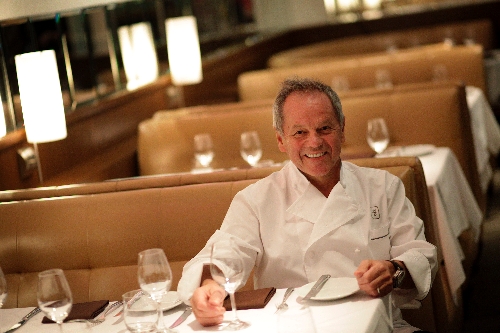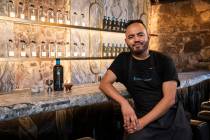From humbling beginnings, Puck’s Spago gave rise to Vegas’ fine-dining movement


Wolfgang Puck’s memories of the early days of the Las Vegas Spago are still razor-sharp after 20 years.
Trauma tends to have that effect.
The restaurant opened with the Forum Shops at Caesars in December 1992, which any Las Vegas veteran – which Puck most assuredly was not – knows is the quietest time in the city.
“We got an amazing review in the newspaper there,” Puck said last week. “When I read the review, I thought we were going to be sold out for six months. And then we had maybe 60 covers that night.”
(For a little perspective: Spago tends to average 800 to 900 “covers” – that would be each customer served – on a given day and as many as 1,400 a day during convention periods, according to Tom Kaplan, senior managing partner of the Wolfgang Puck Fine Dining Group in Las Vegas.)
“I was very nervous,” Puck said without a hint of irony.
A few days later, the National Finals Rodeo came to town, and with it a lot more people, the majority of whom weren’t familiar with this chef who had already found fame for his three California restaurants.
“We had all these cowboys come in,” Puck recalled. “They came up to the counter of the exhibition kitchen and asked if we had any burgers or ribs. They thought it was a buffet line, because they saw the chefs behind there.
“I had to take a bottle of wine home with me every night. That was the only way I could sleep.”
“In that first month,” Kaplan said, “we really thought we’d failed and I was going to be called Bugsy Kaplan and buried in the desert.”
David Robins, managing partner, operations, and corporate chef of the Wolfgang Puck Fine Dining Group in Las Vegas, was, like Kaplan, here with Puck from the very beginning.
“I did get laughed at – and laughed right out of the office – by Jeremiah Tower, who was my chef at Stars in San Francisco,” Robins said. “He told me I was going to the armpit of America, and I was making the biggest mistake of my life.
“It has been a great 20 years for me to validate that I made the right choice in ’92.”
What Puck – and a legion of employees, some of whom remain with him, some of whom have moved on – hath wrought. Widely considered the wellspring of the fine-dining movement in Las Vegas, he now has six restaurants on the Strip. And the city has become home to nearly every lion of the culinary world.
Business picked up pretty quickly around Christmas that first month, and in the early years, Kaplan said, “we had a monopoly.” That changed in 1994 with the opening of the MGM Grand and restaurants from Emeril Lagasse and Mark Miller, which Puck said he had a hand in.
“I convinced them it’s a good place to go; you can do good business,” Puck said.
But then little really changed, he recalled, until the openings of Bellagio and The Venetian.
“That’s when the restaurants really went into overdrive,” he said.
“Only when Steve Wynn opened the Bellagio did things change in a significant way,” Kaplan said. “That’s why I like to consider us the pioneers. We took the risks and the dares.”
In the early years, it was tough to run their kind of business in Las Vegas, Kaplan said; the problem was the availability of good wine and organic produce. He remembers spending at least six months before Spago opened here and most of 1993 sourcing and bringing in items. A lot of the wineries they had bought from directly for their California restaurants wouldn’t ship to Las Vegas, he said.
“There wasn’t enough demand,” he said. “The boutique wineries didn’t think their wines would be served properly. We worked with them and Larry Ruvo (of Southern Wine & Spirits of Nevada) to build a great portfolio of wines.
“We did a lot of foundation work, whether it be produce, fish – you name it.”
Sure, there were plenty of gourmet rooms in town – which Kaplan said catered primarily to the comp crowd. – but they weren’t changing much in a period that was seeing a sea change in America’s culinary world.
“It was kind of bewildering to me,” Kaplan said, “especially coming out of L.A., where there were all of these innovative restaurants; even restaurants in hotels were starting to make progress.
“We came here and they were stuck in old-style service that was very rigid, right down to the sommelier who had the arrogance about him. They were ridiculously overpriced, such poor quality, the wine had no diversity. They had a captive audience and because they were going to give it away they didn’t want to spend much doing it.”
Claude Lambertz, who ran one of those gourmet rooms at the Riviera in the late ’70s, followed by 27 years as a chef instructor at the University of Nevada, Las Vegas, disagrees.
“I think they cared because they gave most of it away,” Lambertz said. “Everybody was basically a high roller. They wanted to make sure they were coming back.”
And he said the old gourmet rooms had a special appeal.
“When you went out for dinner, there was a show that went along with it,” Lambertz said. “The captain, the maitre d’ – from making the Caesar salad all the way up to finishing the sauce.
“That was all taken away and now plates are decorated to the point where people look at it as a piece of art and don’t even want to eat it. The perceived value isn’t there anymore. Do we want to bring the prices down, or do we want to give them more perceived value? I think they’re going to go back to doing something in the dining room that’s more than just bringing food.”
Still, Lambertz said, the changes have been mostly positive.
“I think the menus have become more diverse,” he said. “There’s not the same thing in every restaurant. All the steakhouses, of course, have got steak. But all of the restaurants have little niches, they have things that are different, whereas in the past, you’d go from one to the next, you couldn’t tell where you were.
“It was just a different era, different time. It’s not like that just here in Las Vegas, it’s everywhere. We’re pretty much doing good by making the changes with what we’ve got.”
Puck, Kaplan and Robins stress that they also have invested in the community, through philanthropy and community involvement. Puck’s restaurants have always offered special consideration to locals – “I really believe it’s the locals who make our business,” he said – and during recessionary times, they adjusted their menus to offer lower-priced dishes and kept on as many employees as they could.
“We didn’t just go there to open a restaurant and make money,” Puck said.
“I couldn’t think of a better place to raise my family, and my Wolfgang Puck family,” Robins said.
“I don’t think there’s any other city that has as many upscale restaurants but also as many very good restaurants,” Puck said. “No other city, except maybe New York, in America where you could find a better dining scene.”
As for a legacy, Kaplan said that’s something they accept “humbly.”
“We had no idea Vegas was going to become what it was going to become,” he said. “Really, we got lucky. We were a pioneer, we kind of explored first. It’s safe to say, not arrogantly, that we opened doors for a lot of people. We took risks.
“We didn’t have a master plan. It would be easy to fabricate a story and everyone would believe that. Collectively, it’s the group of people who live and work and reside here who have made the industry. If it wasn’t us, it would’ve been somebody else at some point.”
Contact reporter Heidi Knapp Rinella at
hrinella@reviewjournal.com or 702-383-0474.


















